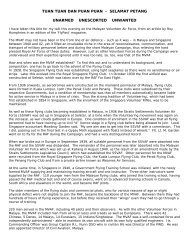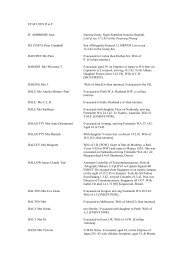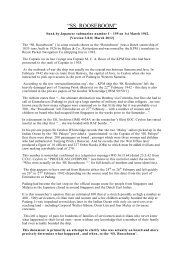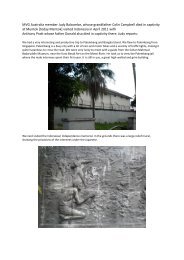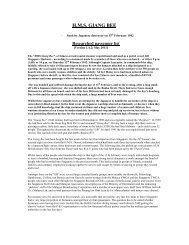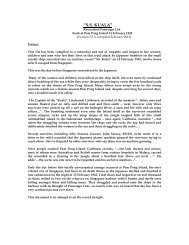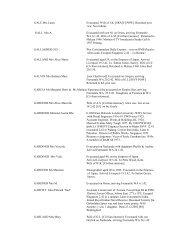Ismail bin Karana's story - Malayan Volunteers Group
Ismail bin Karana's story - Malayan Volunteers Group
Ismail bin Karana's story - Malayan Volunteers Group
- No tags were found...
Create successful ePaper yourself
Turn your PDF publications into a flip-book with our unique Google optimized e-Paper software.
Journal of EventsofPrivate <strong>Ismail</strong> <strong>bin</strong> Karanaof the‘B’ (Malay) Company2 nd (Selangor) BattalionFederated Malay States Volunteer Force.16 January 1942To3 March 1942_____________________Editorial by Ian Logan RichardsonPublished in the <strong>Malayan</strong> <strong>Volunteers</strong> <strong>Group</strong>’snewsletter “Apa Khabar?”, July 2010
Private <strong>Ismail</strong> <strong>bin</strong> Karana, 2 nd (Selangor) Battalion FMSVF, Malaya<strong>Ismail</strong> <strong>bin</strong> Karana, born 1920, an only son, lived in Kampung Bahru, Kuala Lumpur and wasraised by his grandmother. His step-father, English educated, saw he got an excellenteducation and enrolled him at the Victoria Institution in K.L.This was the best English college for <strong>Malayan</strong> boys in Selangor. <strong>Ismail</strong> <strong>bin</strong> Karana is in the2nd row from the top, the small youth 7 th from the right in his first year.Victoria Institution students were sons of <strong>Malayan</strong> Government officials and other influentialbusiness men.<strong>Ismail</strong>Malay Students at the Victoria Institution, Kuala Lumpur in 1936.On the back of the photo is the photographer’s rubber stamp. His name, Nakanishi, isJapanese and no doubt a spy for the Japanese Military intelligence. His wife handled thedressmaking side of the business and catered to the wives of important men in KualaLumpur. While providing quality dressmaking at most reasonable prices she may have evendone in-home fittings to get to know her client’s families.In 1938 <strong>Ismail</strong> joined the V.I. School Army Cadets. As an only son he had been an ardentBoy Scout and the School Cadets was a next natural step. It wasn’t so much he was militaryminded but he liked the comradeship. On leaving the Victoria Institution in 1939 he enlisted
with the FMSVF 2 nd Battalion as a Volunteer reservist. His first employment was at the K.L.General Hospital as a medical assistant trainee.The FMSVF called up <strong>Ismail</strong> bn Karana to mobilise on the 1 st December 1941 at the RifleRange Camp in Kuala Lumpur and was placed in No.6 Platoon “B” Company. He elected tobecome part of the medical team as an ambulance driver.Private <strong>Ismail</strong> <strong>bin</strong> Karana – Front row, right.Rifle Range Camp, Kuala Lumpur. December 1941Private <strong>Ismail</strong> <strong>bin</strong> Karana’s Diary NotesEVENTS OF THE 2 ND WORLD WAR IN WHICH I TOOK PART.December, 19415 Dec 1941 – Mobilised.8 Dec 1941 - War declared on the 8 th : and news of Singapore being bombed.11 Dec 1941 – Went off to Ipoh as an A.D.S.12 Dec 1941 – For the first time saw Japanese planes raiding the Town and a Dog Fightbetween the R.A.F. and the enemy planes took place. Enjoyed seeing the fight.13 Dec 1941 – After the incident more and more Japanese planes came to raid and strangeto say as more and more planes came to raid the less the opposition was.21 Dec 1941 – Forgot most of the happening there (Ipoh) as this diary was written later on.Came back to Kuala Lumpur on 21 st .January, 19429 Jan 1942 – Given 3 months pay in advance (Jan. Feb. and March) and went off to Klang torelieve the former party. Stayed for one night only, and …10 Jan 1942 - ….at 4:00am on the 10 th : we shifted to Puchong – 12 th mile – Puchong EstateHospital. Reason – Probably Japanese had landed at Port Swettenham. Had no rice for thewhole day.11 Jan 1942 – At 12.30am left for an unknown destination, and finally found we arrived atPort Dickson at 6.30am. Given breakfast by the Malay Regiment staff. At 1.00pm we movedto another place about three miles away into a bungalow and met a section of our companythere.12 Jan 1942 – Asked to drive an ambulance as 7 of the MT Company absconded. DroveAmbulance No: V.405 and was machine gunned on the way to Singapore. Escaped. Had norice for the whole day. Reached LABIS at about 10.30pm and slept there for the night. Hadrice in the night and felt greatly relieved of hunger.
13 Jan 1942 – Started again in the early morning for Singapore and reached there about3.00pm.Shifted from St. Patrick’s School to Sultan Trengannu’s Palace (near Roxy Theatre). Took uplorry driving instead of Ambulance since some of the missing crew had come back. On guardat Motor Vehicles’s area.Had the chance to go to the New World Cabaret. Booked $5.00 coupon. The first fun hadsince war broke out. Met a large number of K.L. guys there, especially staff of Survey Dept:and met Inspector Amin of Straits Settlements Police also.14 Jan 1942 – Siren sounded at about 8.30am. Nothing special to note. Went to Singaporetown and for the first time saw the famous Cathay Building (a very striking one) and also thenew Supreme Court.(Ed’s note – The recently built Cathay was the tallest building in South-east Asia at the time.)15 Jan 1942 – None of interest except came to know some girls behind the Ambulance area.Malay film actresses.16 Jan 1942 – Air raid in early morning at about 4:00am. Shifted to Bukit Timah Road andabout 11.00am about 80 - 100 Japanese planes raided Singapore.17 Jan 1942 – Japanese bombed Seletar Naval Base. Oil tank caught fire and smoke couldbe seen for 2 days.18 Jan 1942 – A very quiet day. No raid what-so-ever.19 Jan 1942 – Air-raid at about 8:40am by 45 Japanese planes and again at 11:00am by 48planes.20 Jan 1942 – Air raids for three times. Fairly heavy casualties.21 Jan 1942 – Air raids again. Fairly heavy casualties. In fact the worst so far. Won $40 atgambling.22 Jan 1942 – Went to town with a lorry to fetch things. Bought a wrist watch for $8.50 andswimming goggles for $3.00. Air raids again at 11.00am and 11.30am.23 Jan 1942 – Air raids for four times. Got $11.00 pay from Military. On leave and wentshopping and spent about $8.00 buying biscuits, jam, toothpaste and handkerchiefs.24 Jan 1942 – A quiet day. Went to Johore Bahru to evacuate patients from the JohoreBharu General Hospital at 6:00pm. Night air raid in Johor and search lights very active butno planes spotted.25 Jan 1942 - Came back (from Johore) at 5.00am. Stranded in Singapore with partner(Beng Chye). Slept in the ambulance for the morning, and had no food for the night. Alertsounded but no plane spotted. Of the whole day because of the night work. Started at7.30pm for Camp. Engine trouble and helped by a passer-by. Reached camp at 8.30 the nextmorning26 Jan 1942 – Air raid at 8:25am. Lost $12.00 gambling.27 Jan 1942 – Air raids for six times. Gambled and lost $37.00 Air raid again at night.These two days (26 th and 27 th ) did very hard work. In fact, no rest. Reason - preparing tomake a hospital. (Where?)28 Jan 1942 – Raids for 3 times and 4 times in the night. Greatly annoyed when disturbedfrom sleep – search light very busy.29 Jan 1942 – Few raids. 2 or 3 times during the day and 4 times in the night. Planes threwsmoke screen. Saw for the first time how planes were caught by search-lights. A veryinteresting scene to witness.30 Jan 1942 – Went to town and spent about $8.00 buying biscuits etc. Gambled and lost$10.00 . A few raids in the night.31 Jan 1942 – Up till 12:00 o’clock there were already 6 raids. Had the hardest work so farcarrying firewood. Gambled and lost $32.00.February, 19421 Feb 1942 – Sent to Keranji (with) magazines with a lorry at 5.00am. Lost my way but atlast found it. Japs dropped pamphlets – got 2 of them – Attached to Intelligence section up to9.30pm – a hard and tough day. Gambled and lost $4.00.2 Feb 1942 – Had only $2.50 cash in hand. Early morning sent to Tanglin Malt. Can’t findthe required Battalion. Huge smoke seen in the direction of Seletar – probably petrol tanks
caught fire due to bom<strong>bin</strong>g. Gambled and won about $3.00. Attached to Royal Engineers butcan’t find Barracks. Drove the lorry that we had. A few air raids in night.3 Feb 1942 – Tried again to find R.E. and found. Attached to this unit. Had some accidents,not serious ones. Gambled and won $42.00. Another huge fire seen due to bom<strong>bin</strong>g.4 Feb 1942 – With R. E. caught in a raid on Johnson Pier. Heard explosions like rain closeby. On going back to barrack heard that an unexploded bomb dropped near our place.Gambled and lost $7.00. Shopping $8.00. Slept in R.E. Camp.5 Feb 1942 – With the R.E. Not so much work. Bought a camp-bed for $4.00. Gambled andwon $8.00. Sent home staff of B.E. D.T.M. By Tanjung Pagar way and went by the way roundthe island. Struck by the fine buildings and flats in Tiong Baru. Very beautiful indeed. Saw(bom<strong>bin</strong>g) damage done to Tanjung Pagar and Railway Station.6 Feb 1942 – With the R.E. Not much work. Went round Singapore Town. Some places notseen before. Gambled in the afternoon during tiffin time. Caught by CSM. Names taken downincluding Ah Yew, Ariffin, Teong, Paul and Chin Yee’s friend. Won $36.00 Matter quashedout.In the evening went to Naval Base Samboyang Air Base. Scared by the Artillery firing of theJapanese from Johore. Saw a building about a hundred yards from me being blown off intothe air. Could also hear how the Japanese shells travel. Saw for the first time a Dog Fight inSingapore. (These presumably were real dogs and not aircraft)Heard CSM’s car being spoilt – by putting salt in the petrol tank – by someone from the MFAculprit.7 Feb 1942 – With the R.E. Not much work. Bought a pair of shoes for $3.90 and make 2pairs of trousers for $6.00.8 Feb 1942 – With R.E. Caught in an Air raid in Tanjung Pagar. Bought a Roman sandelshoe for $3.90 and a sarong for $1.65. Had cash in hand $47.96. Could not sleep well asartillery firing was very active. The worst heard so far. Did not stop till morning.9 Feb 1942 – As a result of the ceaseless firing last night came to know the Japanese hadlanded in Singapore. Had a tough day. Back to camp at 12:30 pm.Went to Bukit Timah Village with a convoy – on the way saw all our troops retreating. Ongoing further heard and saw shells going through my lorry. Stopped and took shelter in adrain. People cried, and some running in despair. A horrible scene indeed.Tried to go further and again being shelled. Stopped and turned round and returned back -Returned back - came to know Japanese were already in Jurong - about 4 miles away fromour Camp – Drove lorry with light on and nearly being shot by sentry as I did not hear himshouting to stop. The worst experience so far.10 Feb 1942 – Things seem to go from bad to worse. Troops retreating and new frontseemed to be at Farrer Park Road along Nanyang School and Holland Road.Intense bom<strong>bin</strong>g and machine gunning by the Japanese. None of (our) planes seem flying.Streets full with people both civilians and soldiers. Japanese planes came very low perhapsfor covering fire and our guns too were busy – terrific firing heard.Heard American troops had landed in Penang. Do not know how far it is true. Met Zahariwho told me Abdullah Kamil is in Changi Prison. Heavy artillery firing continued.11 Feb 1942 – Base Depot Store destroyed. Understand the Japanese are only 2 miles away.Seems ZERO hour is coming.Unable to go back to Barracks - told by Military Police and soldiers not advisable for fear ofSnipers as Japs were around there then.Slept in lorry under cover – terrific battery firing heard all night. Nearly hit by splinters.Kept one for a souvenir.12 Feb 1942 – Early this morning machine gun firing was heard close by. Wonder whetherthey were ours or Japs.At 7:00am the sound is becoming clearer and nearer. Jap planes were very busy flying verylow, as low as 200 - 300 feet to cover fire. Our ack-ack guns could do nothing.At one time a plane over me was machine gunning. Do not know where the bullets struckbut I was lucky to escape.Started at 8:00am to find a place as I could not go back to Bukit Timah and by chance metthe Unit in St. Josephs School. Early in the morning a Jap plane caught me napping –probably he is flying at most 80 feet. As I could not do anything I waved a white
handkerchief and showed him the Red Cross on the top of the ambulance. By luck I was leftundisturbed. Had been thinking of father and mother all these days, Ridzwan and grandmaand also all relatives and friends. Dreamt of Jamilah last night.The Coy asked for disbandment. Result – Brigadier “NOT IN FAVOUR”.Slept by the roadside under the lorry. Few shells landed at the School.13 Feb 1942 – Friday the 13 th . As usually the case 13 proved unlucky.Caught in the raid. Bomb fell only 20 yards away from my hiding place. GOSH! The sheltershook like anything, and on going out a few minutes later saw buildings close by being hit. Anarrow escape.At about 12:30pm a shell struck about 20 yards from my makan (food) place - sands got intomy eating plate. Later on another shell burst just a couple of yards away from me – a sparkgot into my eyes.A pitiful scene. All the patients were running away and around in distress.Later on, a shell just miss my lorry, but a few minutes later a direct hit struck it. Oh! theback part was smashed and totally wrecked and a tyre punctured. The worst experience I(ever) had during the day.Again shelling was active during the night. Went to IPOH HOME to arrange for a shelter.14 Feb 1942 – Conveyed Dr. Abas and 6 comrades to abscond away.Shelling and bom<strong>bin</strong>g still around the building - St Josephs. Terribly scared by this anddecided to follow the 7 deserters.Here too shelling was like the one experienced formerly. As deserters we all hid ourselves sonot to give suspicion. Firing was terrible during the night. Terribly scared.15 Feb 1942 – This was the worst of the worst experienced so far. Until 4 or 5 o’clock we bychance tuned the radio to RADIO SAIGON and the happiest of happiest day came whenSingapore surrendered. No wonder the firing was so terrific!16 Feb 1942 – Although war has STOPPED firing still could be heard in the night. It isnatural that some of the troops has not known it yet.Early in the morning anxious to see the condition of the city. Took Amat’s car and sorry tosay the Japs took it away. Went to search for cars. Got a few and were taken by the Japsagain. Again got an M.G. (small sports car)17 Feb 1942 – Went out with Dr. Abas for a walk. Met so many dead bodies and one fellowdied in an armoured car.Jap took away my pen and <strong>bin</strong>oculars and they made a thorough search. Buried alluniforms. Ambulance also taken away.Every now and then worried of how and when to go home. Thought of RIDZWAN very much.In the night for the first time we had bright light again.18 Feb 1942 – Work with M.A.S. Nothing special except anxious of going home.19 Feb 1942 – With M.A.S. (<strong>Malayan</strong> Ambulance Service?) Went to Kampung Melayu. Verypitiful sights seen in some cases. Saw how Chinese were rounded up and marched toChangi.(Editor - <strong>Ismail</strong> didn’t know it then but the Chinese he saw were going off to be executed)20 Feb 1942 – Not much work. Had a hair cut. Heard news that we could go back (home)the next day. Very happy news. Met Adnan Isani.21 Feb 1942 – Paraded at the place where we were told to meet to go back to Kuala Lumpur.Marched to Bukit Timah – H.Q. of K.M.M. Met Abdullah Kamil and others. Some bad newsfrom Sutan Jenain – From there marched to Farrar Park to be Prisoners. Had the mostpainful experience. No proper makan (food) and sleep. MG taken away.Our hearts sank when we were told we had been cheated to be prisoners instead of allowedto go home. Still carry on with a smile.22 Feb 1942 – Life here was really a Hell! What to do is my fate.23 Feb 1942 – As days passed the life becomes harder – only thing is to bear it.24 Feb 1942 – Latest order from the Japanese that the penalty for going against an offenseis to be Shot.25 Feb 1942 – Same life experienced26 Feb 1942 – “ditto”. The orders were a bit stiffened. No one is allowed to go beyond thebarbed wire under penalty of death. (Now unable to go out to buy food)
Went to Raffles Hotel to work up to 7:00pm. Worked to clean lavatories and all sorts of workthat I had not done before.On going back heard the news that we are to be shifted to another place. Happy to hear thenews.27 Feb 1942 – Early in the morning we all felt anxious to know where we are to be brought.We then marched and marched until my shoulder ached to the extreme – wanted to throwmy bags for 3 times - advised by friends not to - but at last my strength could no longerstand and I left the bags in a Malay House at No; 628 Gelang.Stopped at the Hock Heng M.A.S. Post and stayed there for the night. Slept in the open. Hadonly Buber. (gebar? -blanket).28 Feb 1942 – Early in the morning it rained. Everything got wet and about 7:00am startedfor another place near Katong, and stopped at Teluk Kurau English School.Life here just as bad as in Farrar Park.Heard news that we could go the next day between 7:00am and 11:00am. The time passedwithout any news.March, 19421 Mar 1942 – Had practically lost hope, but with God’s mercy at about 3:00pm a JapaneseOfficer brought us the best of all news. We were given passes and allowed to go back to ourrespective homes.At that time I had already borrowed $20 from a friend and now moneyless. Watch takenaway by Japs. After getting the passes we, the former group, went back to the Arabic schoolthe place (where we) first got shelter and slept there for the night - mosquitoes awful!2 Mar 1942 - Early in the morning saw a large group bound for Bukit Timah. As a result 2of our party joined them – Ali Cook and Mat Noh separated from us. Party remained 12.Went to Town to find information of how to go back.On the way stopped by Japs and asked to work. Three ran away.No definite information received. Went to Mokhtar and Pak Cik ZAA (ZAABA’s) house andwalked not less than 20 miles. Passed the night with plenty of mosquitoes.In the days following – In my case, I together with four others managed to befriend aJapanese Military Lorry Driver going to Kuala Lumpur to carry us. He agreed to do so on thepromise we all pay him $40.00 each in British currency. He refused to take JapaneseBanana currency. What a Joke!How this driver shield or hide us inside the lorry between Petrol Drums and other items hewas carrying to avoid detection from various sentries was another thrilling episode.”(Editor’s note – As refugees fled south down the <strong>Malayan</strong> peninsular Singapore’s populationincreased by almost a million. The Japanese Military authorities on occupation of Singaporerealized there was insufficient housing and food to handle them and the situation woulddeteriorate quickly. So after a short time permits were given out for people to return back to theirhomes in Malaya – at their own expense. Trains bringing down Japanese military supplies fromThailand were used as passenger trains for returnees.)“However, as one who was directly involved in this day-to-day affair I still have a faint idea ofwhat actually happened. How people travel on the top of the train to come back home onlt tomeet tragic deaths when the train pass through a bridge or tunnel in the dark of nightwithout their knowledge.”This is the end of <strong>Ismail</strong> <strong>bin</strong> Karana’s diary entries. Some years later when he transcribed thepreceding diary entries into typewritten notes he added below:-“In this case I am just rewriting what was actually written by me in the small diary which Imanaged to salvage from my junk.It is sad and unfortunate that I was not able to continue to write this diary after the 2 nd ofMarch, 1942. It was possible that I had been a worried man thinking of how to come back toKuala Lumpur to meet my parents, or, that I do not have the time to do it, Thinking howvaluable the information could be today, I just could say “IT IS A SHAME”.Maybe also that I was too happy that the war had ended.
In conclusion, Let Us All Hope That There Will Be No Other War.”Private <strong>Ismail</strong> <strong>bin</strong> Karana,6 th Platoon, B Company2 nd Batalion, FMS Volunteer Force.SelangorEditor’s commentarySome of the <strong>Malayan</strong> <strong>Volunteers</strong> who were initially put into Farrar Park POW camp along with theBritish Indian regiments, I believe, were executed and had <strong>Ismail</strong>’s connection to the Royal Engineers beknown he may well have not survived. Most of the Chinese officers and some of the Chinese ORs werethe main targets for execution. A few Malay officers who openly stood by their Chinese comrades werealso murdered. Mustapha Hussein’s autobiography, “Malay Nationalism Before UMNO” described thesituation very clearly and in great detail. The Indians were ‘persuaded’ to join the INA and the Malays,the Japanese Volunteer Army. Eurasians were initially let off until it was realised they were cooperatingwith the resistance forces and a crackdown took place 8 months after the fall of Singapore anda number of Eurasian officers and NCOs were arrested and some were killed. At the time <strong>Ismail</strong> wasreleased Malays were not yet considered for ‘recruiting’ for railway work parties up in Burma but theywere considered ready for recruitment into the Japanese Volunteer Army, a parody of the VolunteerForces and recruitment began even before the fall of Singapore from Malay Volunteer stragglers anddeserters.<strong>Ismail</strong> made it back to his home in Kampung Bahru in Kuala Lumpur. Soon after the Japanese startedthe recruiting drive for Malay and Indian citizens to work on the railways. However it did not take longfor escapees from Burma to return to Malaya with dreadful stories of the conditions they were forced towork under. With no volunteers the Japanese then started press-gangs who raided amusement parks andculled out the numbers they wanted.<strong>Ismail</strong>’s mother saw <strong>Ismail</strong> as being a prime target of the Japanese recruiters for work parties for Burmaand decided he had to marry quickly. A suitable wife was found for him and after all the traditionalcustoms were carried out and he was married on the 3 rd January 1943 to a girl he had never laid eyes on.
The Marriage of <strong>Ismail</strong> <strong>bin</strong> Karana & Ayum bt. Salimin.At her parent’s home in Cheras, Kuala Lumpur – 3 Jan 1943After the war <strong>Ismail</strong> collected his 4 medals and to this day proudly displays them in a glass ca<strong>bin</strong>et inhis Gombak living room. He went on to become a manager of an orphanage of boys and a senior memberin the Boy Scouts organization while raising five daughters and a son. By shrewd investment in land andhouses he became wealthy and as of today, September, 2010, he has passed his 90 th birthday.
<strong>Ismail</strong> <strong>bin</strong> Karana’s War MedalsThe four on the right – from left, 4 th the 1939-’45 Star, 5 th ,the Pacific Star, 6 th , the Defense Medal



